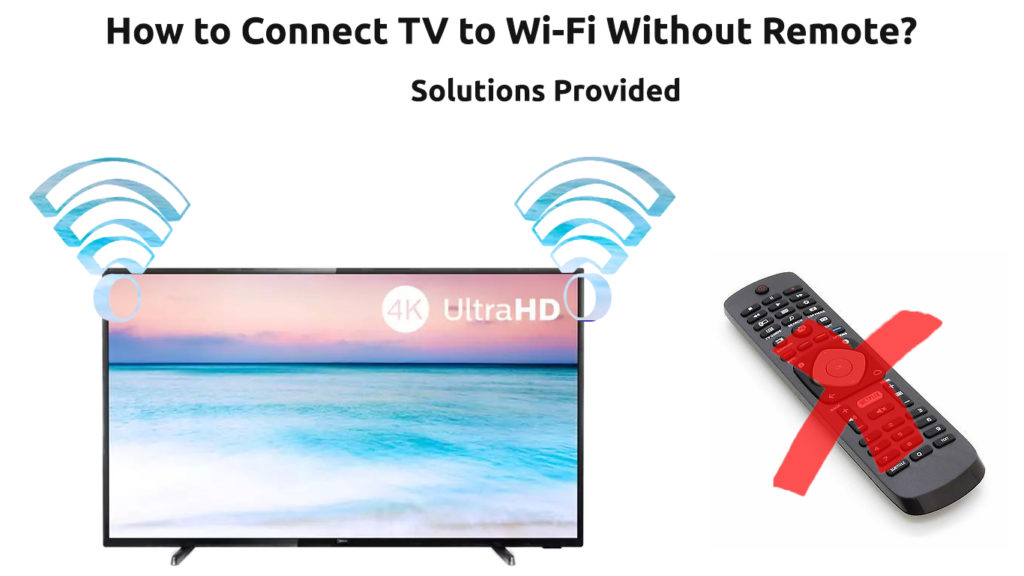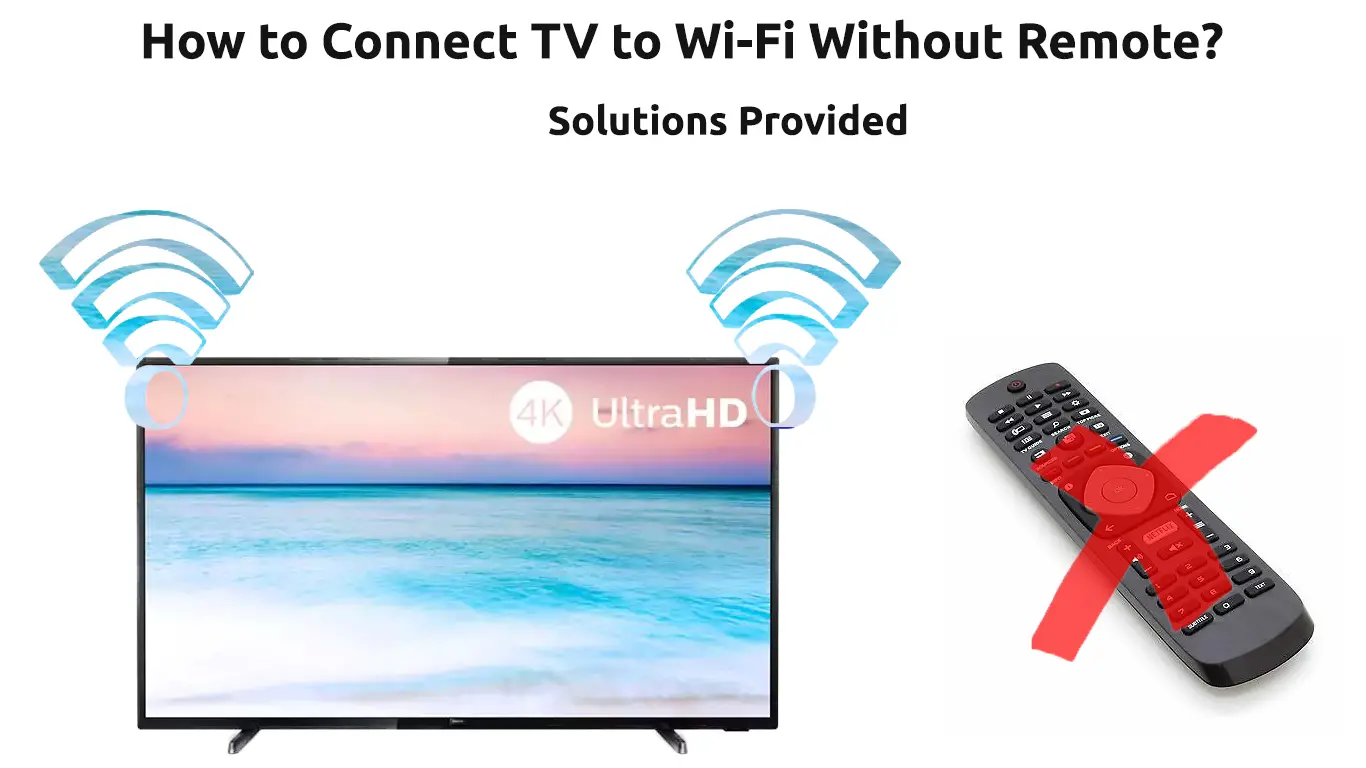Have you ever lost a remote? I know I have. We don’t really think that much about the importance of remotes until we lose them. But when we do, it becomes painfully obvious how important they are. Everything is much harder when you don’t have your remote, even simple things like changing channels.
One of the most difficult things to do when you don’t have a remote is to connect your TV to Wi-Fi. Once you connect it to Wi-Fi, you can use some TV remote app (official or unofficial) to control everything, but you can’t use the app if the TV is not connected. But don’t worry! Connecting TV to Wi-Fi without a remote is not impossible, and we are here to show you how to do that.

CONTENTS
Connect TV to Wi-Fi Using a USB Mouse or a Keyboard
Look for USB ports on your TV. They are normally placed either at the sides or the back. Modern TVs usually have multiple USB ports so that you can play media content through a USB pen or external hard drive. In addition, you can also connect a USB keyboard and mouse to these ports. Once the TV detects the keyboard or mouse, you can use it to navigate through TV settings and link them to a Wi-Fi network.
In most cases, wired and wireless keyboards and mice are plug-and-play devices. They don’t require driver installation or anything like that. You just connect them to your TV, and they work.
Modern TVs have a built-in wireless adapter that enables a Wi-Fi connection. However, it’s best to place the TV in the same space as the router for maximum Wi-Fi signal since recent movie streaming platforms require a strong signal.
Follow these steps to connect:
- Go to the Network Settings.
- Set up a wireless connection.
- Select your home Wi-Fi network.
- Connect the TV to the Wi-Fi using the correct password.
Before using your keyboard/mouse to Wi-Fi, you may have to use those physical buttons (or just one button/joystick) on the bottom or back of your TV to change the source (select Live TV or one of the active HDMI inputs). Below, you can see a video tutorial on how to connect an LG TV to Wi-Fi using a wireless mouse.
Connecting an LG TV to Wi-Fi Using a Wireless Mouse
Connect TV to Wi-Fi Using a Smartphone App
As an alternative to a USB keyboard and mouse, you can try linking the TV to Wi-Fi using a smartphone app. But wait – haven’t we just said that you can only use the app after you connect your TV to Wi-Fi. Well, yeah, but there’s a workaround. However, this workaround will only work if you know the exact name and password of at least one Wi-Fi network your TV was connected to at some point in the past. If you don’t know them, this method won’t work.
Now, why do you need to know the exact name and password of some old Wi-Fi network? Well, because your TV has that network memorized, which means it can connect to that network automatically. So, if you happen to know the old network name and password, you have two options.
The easier option is to change your new Wi-Fi name and password using your router’s settings. The moment you change them and save the settings, your TV will recognize the network and will connect to it. From there, you can use your official or unofficial TV remote app to control other settings.
Naturally, you will first have to connect your phone or tablet to the same Wi-Fi network. In this case, you don’t really have to use the app to connect TV to Wi-Fi – you just have to use it to control the TV after it connects to Wi-Fi.
If you, however, do not have access to your router’s settings, your only option is to use your TV remote app to connect the TV to Wi-Fi. To do this, you will have to use two phones – one with the app installed on it, and one that’s going to be a temporary hotspot. Here’s what you need to do.
First, set up a mobile hotspot on one of your phones. You can’t use the default name and password for the hotspot – they have to match the name and password of that old network your TV was connected to. That’s the only way to “force” your TV to connect to your hotspot automatically.
Once you set up your hotspot, you can install the TV remote app on the other phone. Some manufacturers have their own official apps and some use third-party operating systems (Android OS, Fire OS, Roku OS) for their TVs and they also come with official apps. On rare occasions, you may have to use some third-party remote app, but you will have to find the app that works for your TV.
Once you install your app, you should connect the phone to the hotspot. Also, turn on your TV. The TV will connect to the hotspot automatically. Your phone will also be connected to the same hotspot. So, they will be on the same Wi-Fi, which means that you can control the TV with your app.
You just need to use the app to access the Network Settings on your TV, find your new Wi-Fi after scanning for available networks and connect to it. After your TV connects to the new Wi-Fi, you can turn off the hotspot and connect your phone (the one with the app) to the new Wi-Fi.
How to Connect a Roku TV to Wi-Fi Using the Roku app
Connect TV to Wi-Fi Using an Ethernet Cable
Don’t worry – we know that Ethernet is not Wi-Fi. In this case, we’re going to use an Ethernet connection as a temporary solution. A bypass, if you want. Have in mind that this will only work if your TV has an Ethernet port. Here’s what you need to do.
Run an Ethernet cable from your router (one of the LAN ports) to your TV’s Ethernet port. The moment you connect them, the TV will have internet access (because a wired connection doesn’t require password). Once your TV connects to the internet, take your phone and open the TV remote app (install the app prior to that).
Naturally, your phone should be connected to the same network via Wi-Fi. Use the app to access the network settings on your TV and connect it to Wi-Fi. Once you connect it to Wi-Fi, you can unplug the Ethernet cable. Your TV will stay connected to the Wi-Fi.
Conclusion
The next time you lose your TV remote, you should know how to connect TV to Wi-Fi without remote. In this guide, we have explained multiple ways to do that and, hopefully, one of the ways will work for you.

Hey, I’m Jeremy Clifford. I hold a bachelor’s degree in information systems, and I’m a certified network specialist. I worked for several internet providers in LA, San Francisco, Sacramento, and Seattle over the past 21 years.
I worked as a customer service operator, field technician, network engineer, and network specialist. During my career in networking, I’ve come across numerous modems, gateways, routers, and other networking hardware. I’ve installed network equipment, fixed it, designed and administrated networks, etc.
Networking is my passion, and I’m eager to share everything I know with you. On this website, you can read my modem and router reviews, as well as various how-to guides designed to help you solve your network problems. I want to liberate you from the fear that most users feel when they have to deal with modem and router settings.
My favorite free-time activities are gaming, movie-watching, and cooking. I also enjoy fishing, although I’m not good at it. What I’m good at is annoying David when we are fishing together. Apparently, you’re not supposed to talk or laugh while fishing – it scares the fishes.

